Overview
Diagnostic analytics addresses essential questions about the underlying causes of past events and trends. For instance, it seeks to understand why sales have declined or what factors have influenced customer churn. Analyzing historical data is crucial for uncovering these root causes, ultimately enhancing decision-making processes.
A compelling illustration of this can be seen in the successful case study of Canadian Tire, which effectively utilized AI-driven insights to boost sales. This example underscores the value of diagnostic analytics in driving informed business strategies.
Introduction
In the rapidly evolving landscape of data analytics, diagnostic analytics stands out as an essential tool for organizations aiming to grasp the complexities of their operations. By investigating the reasons behind historical events, this analytical approach not only addresses the crucial question of ‘why’ but also empowers businesses to enhance decision-making and operational efficiency. As industries contend with an ever-growing volume of data—projected to reach an astonishing 79.4 zettabytes by 2025—leveraging diagnostic analytics becomes vital for pinpointing root causes of issues and uncovering actionable insights.
The applications of diagnostic analytics are extensive and transformative, ranging from optimizing sales strategies to improving patient care in healthcare settings. This article delves into the core aspects of diagnostic analytics, exploring its methodologies, real-world applications, and the challenges organizations encounter during implementation. Ultimately, it underscores the pivotal role of diagnostic analytics in driving growth and innovation across various sectors.
Understanding Diagnostic Analytics: Definition and Purpose
Diagnostic analytics represents a vital branch of analytical study, delving into the reasons behind past occurrences or trends. It specifically addresses the question: what does diagnostic analytics answer? By scrutinizing historical data, organizations can reveal the root causes of issues, a necessity for informed decision-making and improving future outcomes. This analytical approach gains particular significance in today’s data-rich landscape, where the number of connected devices is projected to surge from 16 billion in 2023 to 20.3 billion by 2025, generating an astonishing 79.4 zettabytes of data.
Such vast amounts of information necessitate robust analytical frameworks to extract practical insights, underscoring the critical need for effective evaluative analysis. The importance of evaluative analysis in enhancing operational efficiency cannot be overstated. It enables organizations to pinpoint inefficiencies and tackle challenges proactively. For instance, Canadian Tire effectively harnessed AI-driven insights to analyze the purchasing behaviors of new pet owners, achieving nearly a 20% increase in sales by identifying cross-selling opportunities.
This case illustrates how diagnostic analytics can convert raw data into strategic insights that propel revenue growth. Experts assert that leveraging Robotic Process Automation (RPA) solutions, such as EMMA RPA and Microsoft Power Automate from Creatum GmbH, can significantly boost efficiency and employee morale by automating manual workflows. Furthermore, understanding past events through diagnostic analytics addresses the fundamental question of what diagnostic analytics answers, essential for organizations striving to refine their operations. By integrating tailored AI solutions and Business Intelligence tools, organizations can enhance their decision-making processes, ensuring strategies are informed by historical performance and trends.
The use of Power BI services, including the 3-Day Sprint for rapid report generation, further enhances information reporting and actionable insights, addressing inconsistencies and governance challenges in organizational reporting. Expert opinions emphasize that comprehending the reasons behind past events is crucial in commercial analysis, as it helps answer what diagnostic analytics addresses, laying the groundwork for future achievements and innovation. In summary, analytical assessment serves as a cornerstone for organizations aiming to bolster operational efficiency and navigate the complexities of their data environments.
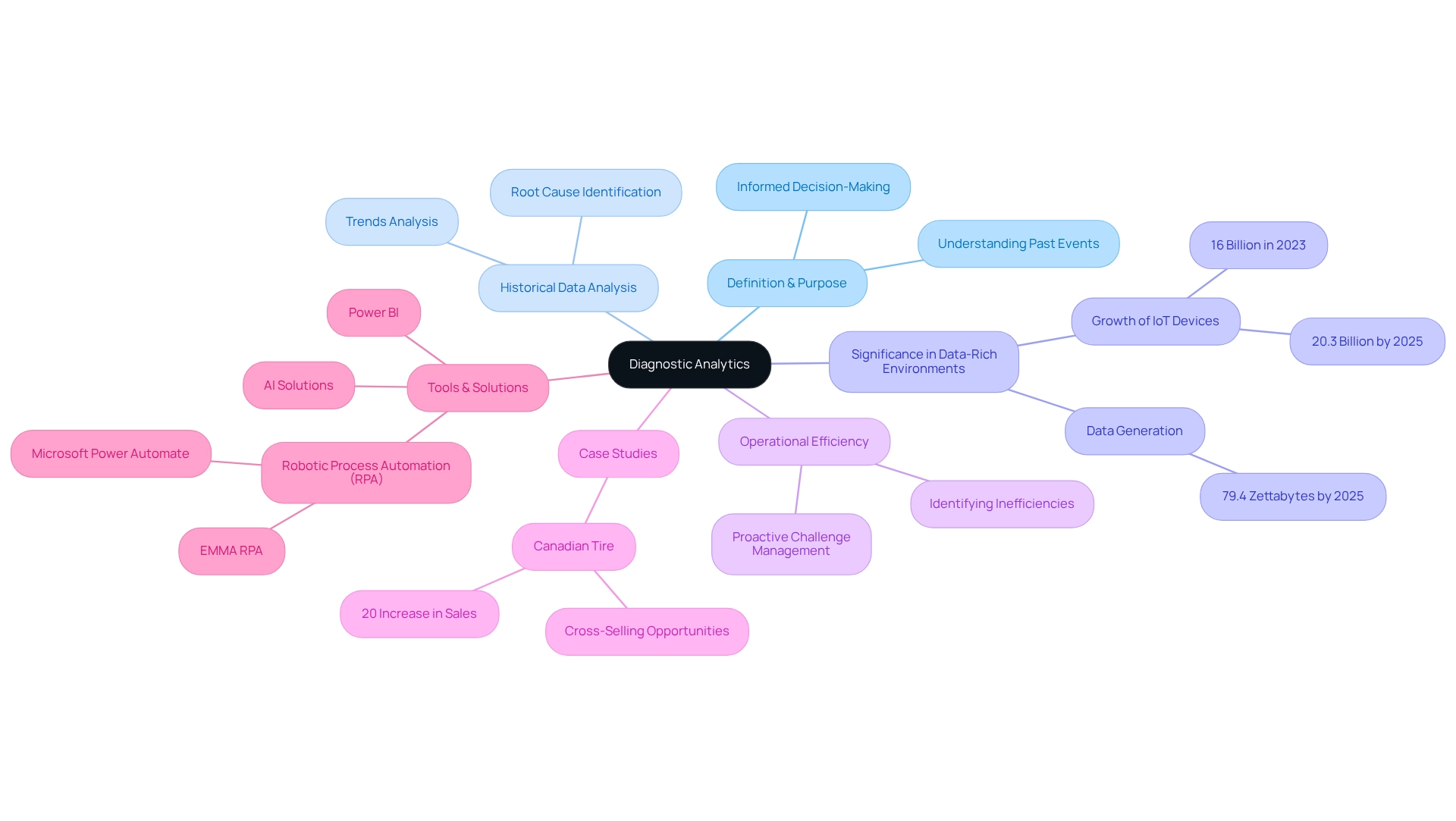
Key Questions Addressed by Diagnostic Analytics
Diagnostic analysis is pivotal in addressing the question of what diagnostic analytics reveals about organizational performance. Key inquiries include:
- ‘Why did sales decline during a specific period?’
- ‘What factors contributed to increased customer churn?’
- ‘Why did a marketing campaign fail to generate expected results?’
By systematically addressing these questions, organizations can uncover underlying issues and formulate targeted strategies to prevent recurrence.
For instance, companies often utilize regression analysis to pinpoint outliers that may skew the relationship between variables, such as the correlation between advertising expenditure and sales results. This analytical approach not only clarifies these relationships but also enhances decision-making processes.
The impact of evaluative analysis on organizational performance is significant. Organizations that effectively harness these insights, particularly through the integration of Business Intelligence tools, can improve customer retention rates, as retaining existing customers is generally more cost-effective than acquiring new ones. This principle underscores the importance of understanding customer behavior through analytical evaluation, which can be further enhanced by Robotic Process Automation (RPA) to streamline information gathering and examination procedures.
Moreover, case studies indicate that companies facing sales declines have successfully employed analytical assessments to identify root causes, yielding actionable insights that bolster performance. However, it is crucial to address challenges such as differentiating correlation from causation and ensuring data quality to derive accurate insights. The demand for advanced analytical skills further complicates the effective application of assessment techniques.
As Catherine Cote, Marketing Coordinator, states, “Do you want to become a data-driven professional? Explore our eight-week course and our three-course Credential of Readiness (Core) program to deepen your analytical skills and apply them to real-world business problems.” By overcoming these obstacles, organizations can unlock the full potential of diagnostic data analysis, ultimately fostering growth and innovation in their operations.
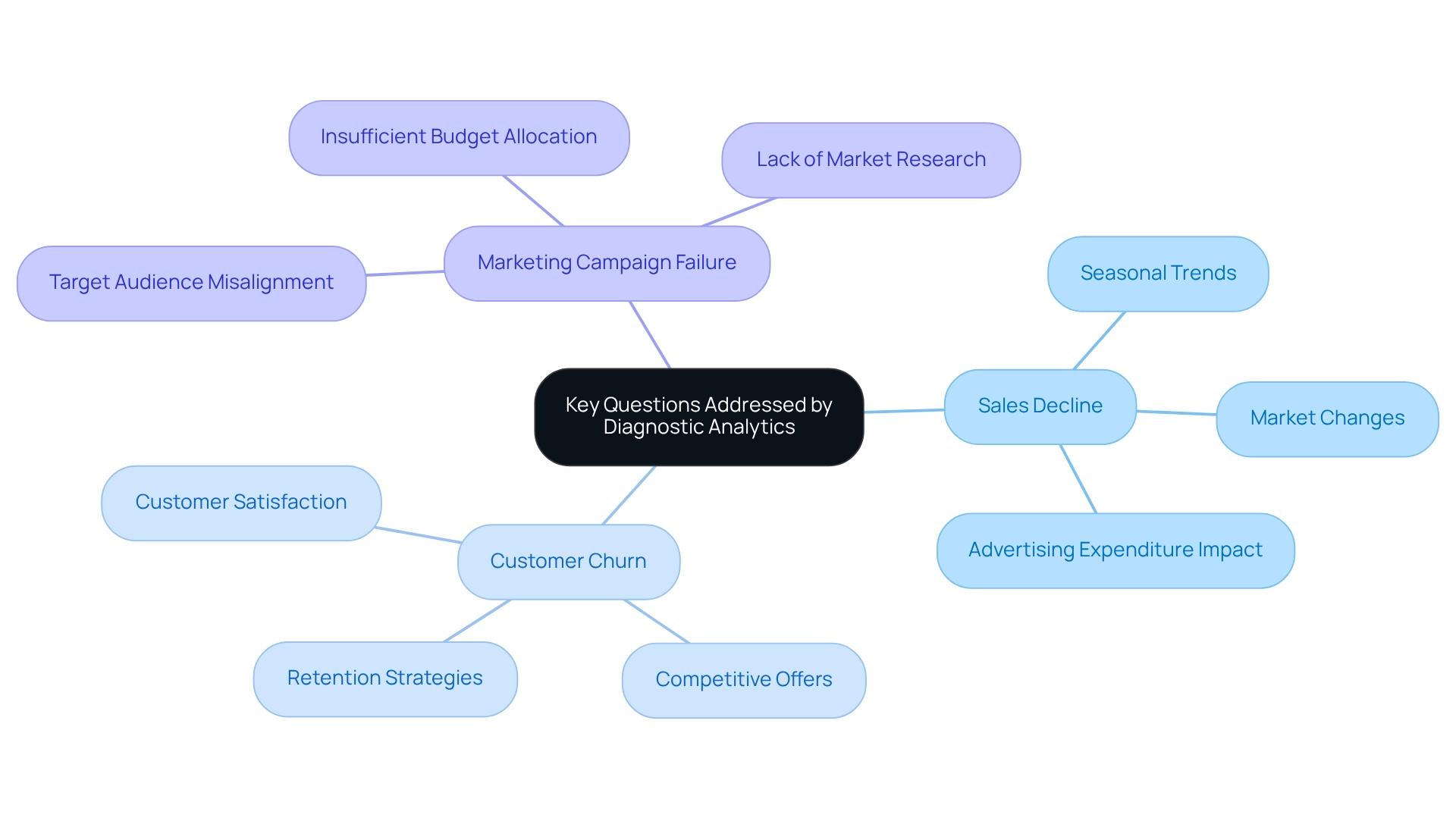
Techniques and Methodologies in Diagnostic Analytics
In today’s overwhelming AI landscape, one might wonder: what question does diagnostic analytics answer? This field employs a range of techniques crucial for revealing insights from information. Among the most prominent methodologies are:
- Regression analysis
- Correlation analysis
- Root cause analysis
These can be enhanced through tailored AI solutions from Creatum GmbH, aligning with specific business goals.
Regression analysis is a powerful tool that identifies relationships between variables, allowing organizations to understand how changes in one factor can influence another. This technique has gained traction in recent years, reflecting a growing reliance on data-driven decision-making. As Jan Hammond, a Harvard Business School Professor, states, “Regression enables us to obtain insights into the structure of that relationship and offers measures of how well the information aligns with that relationship.”
Organizations employing regression analysis can substitute intuition with empirical information, leading to more informed decisions and improved operational performance.
Correlation analysis complements regression by assessing the strength and direction of relationships between variables. This technique is particularly valuable for organizations seeking actionable insights, as it helps identify which factors are most closely linked to desired outcomes. Numerous enterprises have effectively utilized correlation analysis to enhance their strategies and deepen customer insight, ultimately fostering innovation.
Root cause analysis delves deeper into information, aiming to uncover the underlying reasons for specific outcomes. This technique is crucial for identifying business problems and implementing effective solutions. Current statistics indicate that organizations employing root cause analysis experience marked improvements in problem-solving capabilities, enabling them to address issues proactively rather than reactively.
As we approach 2025, the landscape of diagnostic analytics continues to evolve, with methodologies such as hypothesis testing, anomaly detection, and visualization becoming increasingly common. Data representation plays a crucial role in simplifying intricate relationships, making it easier for stakeholders to grasp insights swiftly. The past decade has seen companies becoming more reliant than ever on information, underscoring the significance of these developing methodologies in enhancing operational efficiency and organizational growth.
However, companies struggling to extract meaningful insights may find themselves at a competitive disadvantage.
Case studies illustrate the effectiveness of these techniques. For instance, the case study titled ‘Improving Business Decisions through Information Analysis’ emphasizes how information analysis enhances decision-making by offering insights that substitute intuition with factual evidence. Organizations that have leveraged regression and correlation analysis have reported significant improvements in their decision-making processes, leading to a competitive advantage in their respective markets.
By utilizing these diagnostic evaluation methods and the strength of Business Intelligence, companies can convert raw information into actionable insights, promoting growth and innovation.
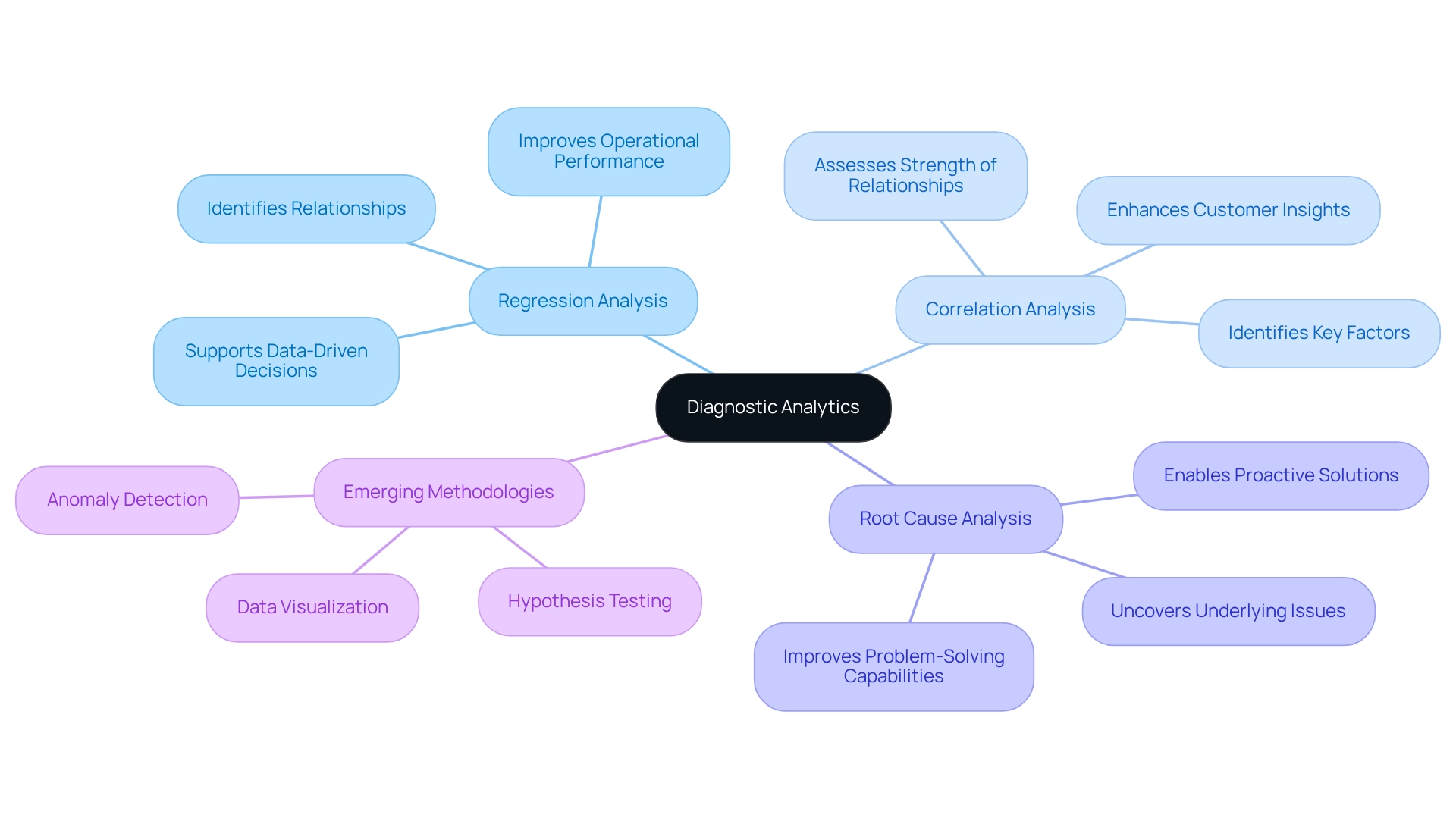
Real-World Applications of Diagnostic Analytics Across Industries
Understanding the role of diagnostic analytics across various industries reveals its capacity to answer critical questions that drive significant improvements in operational efficiency and decision-making. In healthcare, for example, diagnostic analytics is instrumental in identifying the underlying causes of patient readmissions. By thoroughly examining patient information, hospitals can uncover specific factors contributing to readmissions, enabling them to implement targeted interventions that enhance care quality and patient outcomes.
A noteworthy case study from Creatum GmbH illustrates how a mid-sized healthcare firm achieved remarkable efficiency by automating information entry and software testing through GUI automation. This implementation not only reduced information entry errors by 70% but also accelerated testing processes by 50%, culminating in an impressive 80% enhancement in workflow efficiency. Such measurable outcomes underscore the transformative impact of Creatum’s technology solutions on operational efficiency within healthcare services.
Moreover, personalized chronic disease management is significantly improved through the analysis of patient information, facilitating the development of customized care plans tailored to individual needs. Continuous evaluation, driven by patient feedback data, fosters a culture of excellence in healthcare delivery, ultimately elevating patient care standards.
In the retail sector, data analysis proves equally revolutionary. Businesses harness these techniques to gain insights into customer behavior, addressing pivotal questions that diagnostic analytics can answer, which informs inventory management strategies. For instance, Canadian Tire utilized AI-driven analysis to scrutinize purchasing behavior, leading to an impressive 20% increase in sales.
This demonstrates how understanding customer preferences through analytical assessments can effectively address what diagnostic analytics answers, ultimately optimizing stock levels and minimizing surplus inventory to enhance profitability.
Furthermore, diagnostic analysis plays a crucial role in finance, addressing key questions by enabling organizations to examine transaction data and reveal fraud patterns. By leveraging these analyses, financial institutions can identify anomalies and mitigate risks, thereby protecting their operations and maintaining customer confidence. As Trinity Cyrus, Marketing Coordinator, states, ‘Prescriptive analysis is used to recommend actions to optimize outcomes,’ illustrating the broader spectrum of data analysis that supports informed decision-making.
These examples highlight the versatility of analytical methods, showcasing their ability to drive enhancements and improve operational efficiency across diverse sectors, from healthcare to retail and finance. The distinctive value offering of organizations lies in delivering tailored solutions that enhance data quality and streamline AI implementation, ensuring businesses can effectively leverage these insights for growth and innovation.
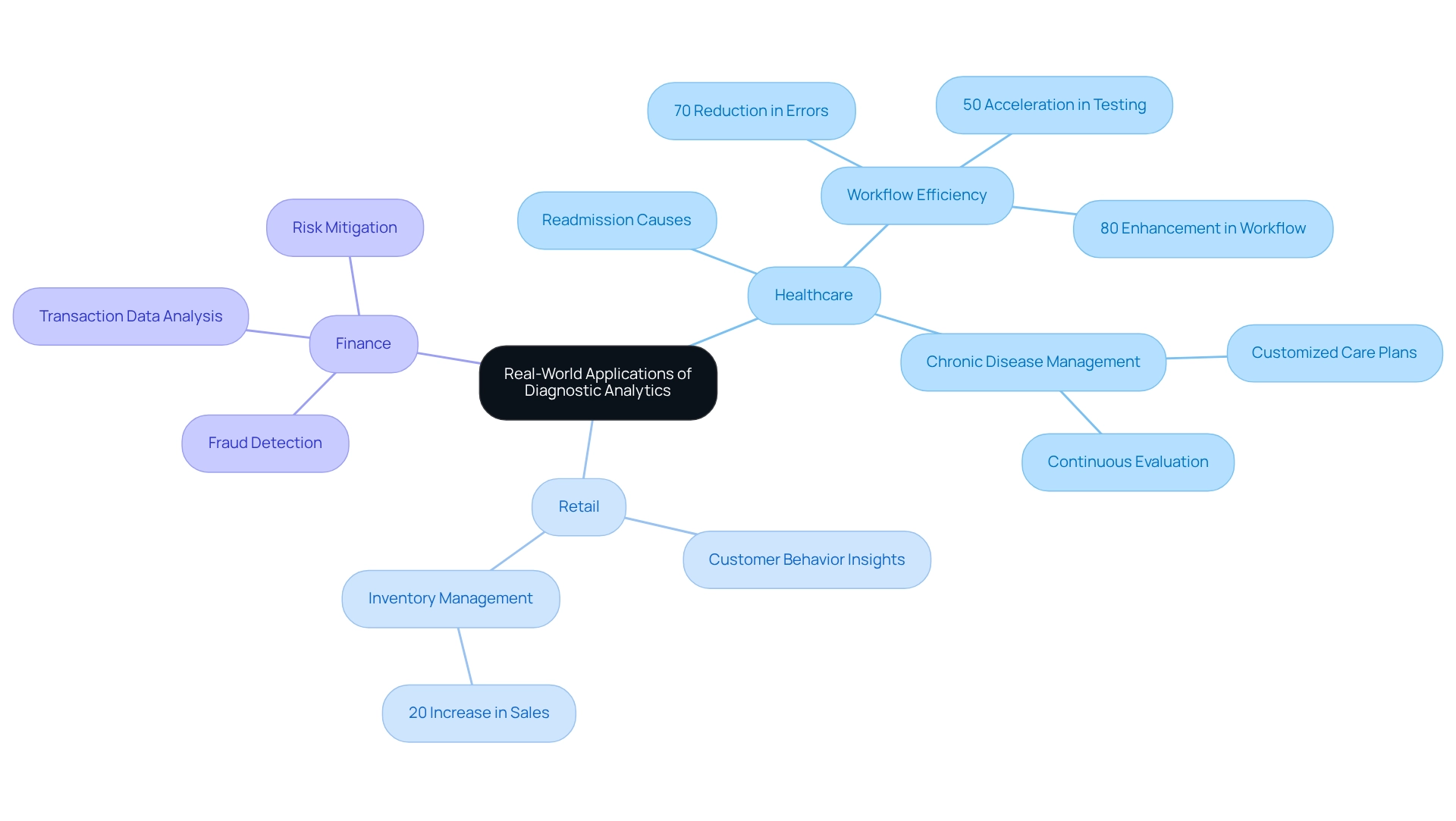
Benefits and Challenges of Implementing Diagnostic Analytics
Applying assessment analysis offers numerous advantages, including enhanced decision-making capabilities, increased operational efficiency, and the proactive identification and resolution of issues. Organizations that leverage data analysis gain a deeper understanding of their performance, empowering them to make informed, timely decisions that promote growth. As one expert noted, “Data analysis allows business leaders to make informed, timely decisions and gain greater insights into their operations and clients.”
A pivotal aspect of analytical diagnosis is its ability to uncover the root causes of performance issues by addressing the essential inquiries of diagnostic analytics. However, the path to effective implementation is fraught with challenges. Quality concerns often emerge as a significant barrier, as inaccurate or incomplete data can lead to misleading conclusions.
Moreover, employee resistance to change can hinder the adoption of new analytical processes, as staff may be reluctant to abandon familiar practices. The requirement for specialized skills to analyze data effectively further complicates the landscape, as organizations may struggle to find or develop talent proficient in analytical evaluation. To fully harness the benefits of diagnostic analytics, it is crucial to grasp the fundamental questions that diagnostic analytics seeks to answer.
To navigate these challenges, organizations can employ Robotic Process Automation (RPA) to streamline data collection and processing, thereby enhancing quality and minimizing the time spent on manual tasks. Additionally, customized AI solutions can assist businesses in navigating the rapidly evolving technological landscape, ensuring they adopt the appropriate tools aligned with their specific requirements. The integration of Business Intelligence can transform raw data into actionable insights, facilitating informed decision-making that drives growth and innovation.
For example, Canadian Tire’s experience exemplifies the transformative potential of these strategies. By utilizing ThoughtSpot AI-Powered Analytics to examine the purchasing behavior of new pet owners, the company identified cross-selling opportunities, resulting in an impressive 20% increase in sales within their pets department. This case underscores the importance of addressing data quality issues and fostering a culture open to change, as these factors are vital for realizing the full benefits of data analysis.
Furthermore, organizations that effectively implement analytical assessments can expect improvements in employee satisfaction and retention, as these evaluations enhance hiring processes by identifying the traits of successful candidates. As companies navigate the complexities of implementing diagnostic data analysis, focusing on these advantages while addressing the associated challenges will be essential to unlocking their full potential.
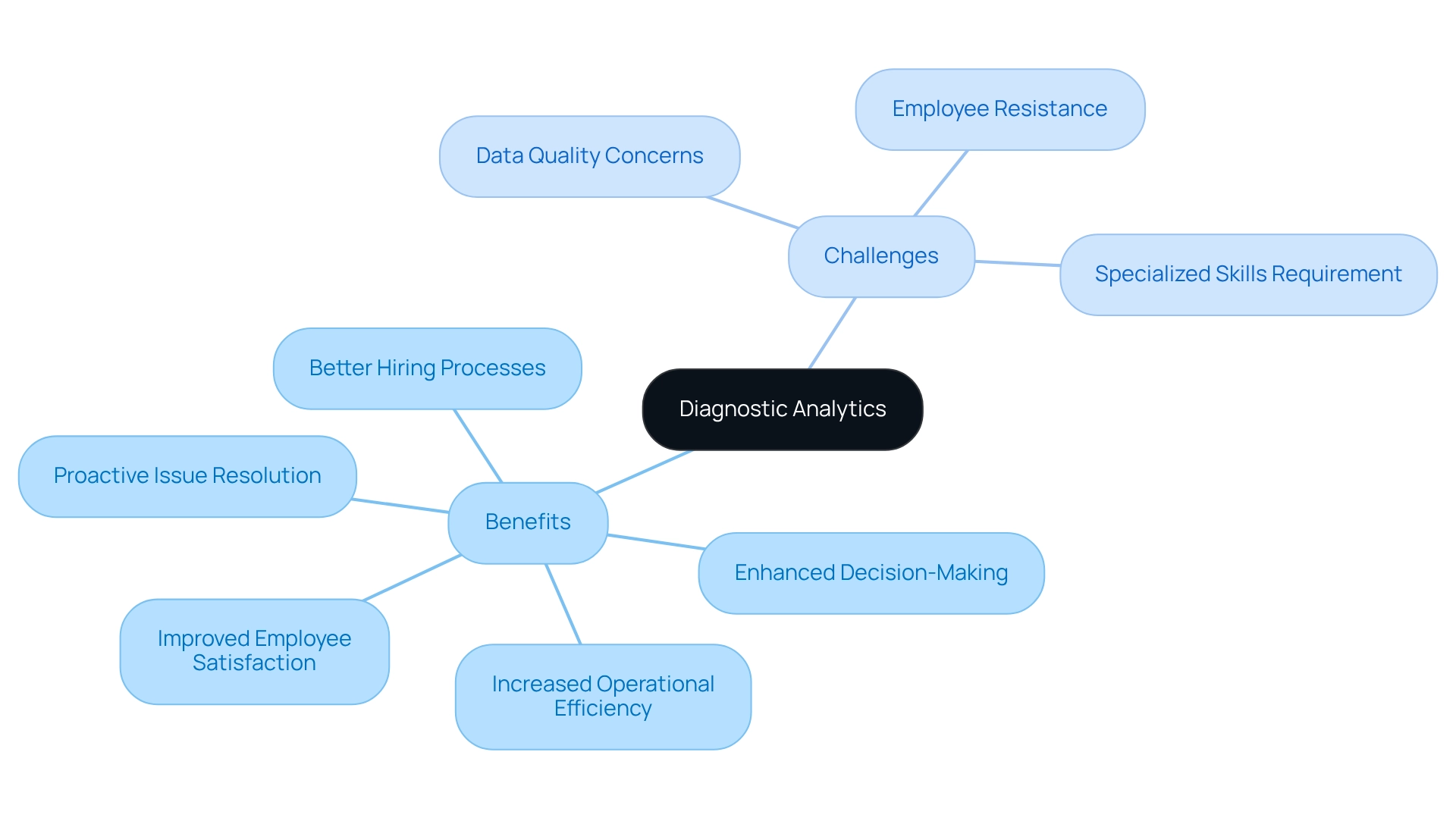
Diagnostic Analytics vs. Other Analytics Types: A Comparative Analysis
In the analytical landscape, diagnostic analysis is pivotal, as it addresses the question: what does diagnostic analytics answer? This form of analysis distinguishes itself from descriptive, predictive, and prescriptive analytics. While descriptive analysis answers ‘What happened?’, diagnostic analytics delves deeper, exploring ‘Why did it happen?’.
This deeper analysis is essential for organizations seeking to understand the underlying causes of trends and anomalies in their data. In today’s overwhelming AI landscape, identifying the right solutions can be daunting. The challenges of navigating this environment can hinder companies from making informed choices, highlighting the need for customized solutions from Creatum GmbH.
As Akash Jha observes, “By utilizing the correct kind of analysis at the suitable phase, companies can obtain valuable insights, make informed decisions, and ultimately propel success in an increasingly competitive and data-driven environment.” Predictive analysis, on the other hand, uses historical information to forecast future results, assisting businesses in anticipating potential challenges and opportunities. Meanwhile, prescriptive analysis advances this approach by recommending specific actions to achieve desired outcomes based on data examination and various scenarios.
Understanding these distinctions is crucial for organizations aiming to select the most appropriate analytical approach for their specific needs. For instance, a financial organization efficiently employs predictive analysis to assess credit risk by examining applicants’ credit histories, forecasting the probability of loan defaults. In contrast, an energy company utilized diagnostic analysis to investigate a sudden rise in energy usage.
By analyzing consumption data and customer behavior, they determined whether the increase stemmed from seasonal changes or inefficiencies in their distribution system.
Furthermore, statistics indicate that prescriptive analysis can provide actionable insights, such as recommending A/B tests for targeted advertising, significantly enhancing marketing effectiveness. This comparative study underscores how analytical evaluations not only improve predictive and prescriptive methods but also serve as a fundamental component in the decision-making process. By integrating tailored AI solutions from Creatum GmbH and leveraging the power of Business Intelligence, organizations can drive informed decisions and foster growth in an increasingly competitive landscape.
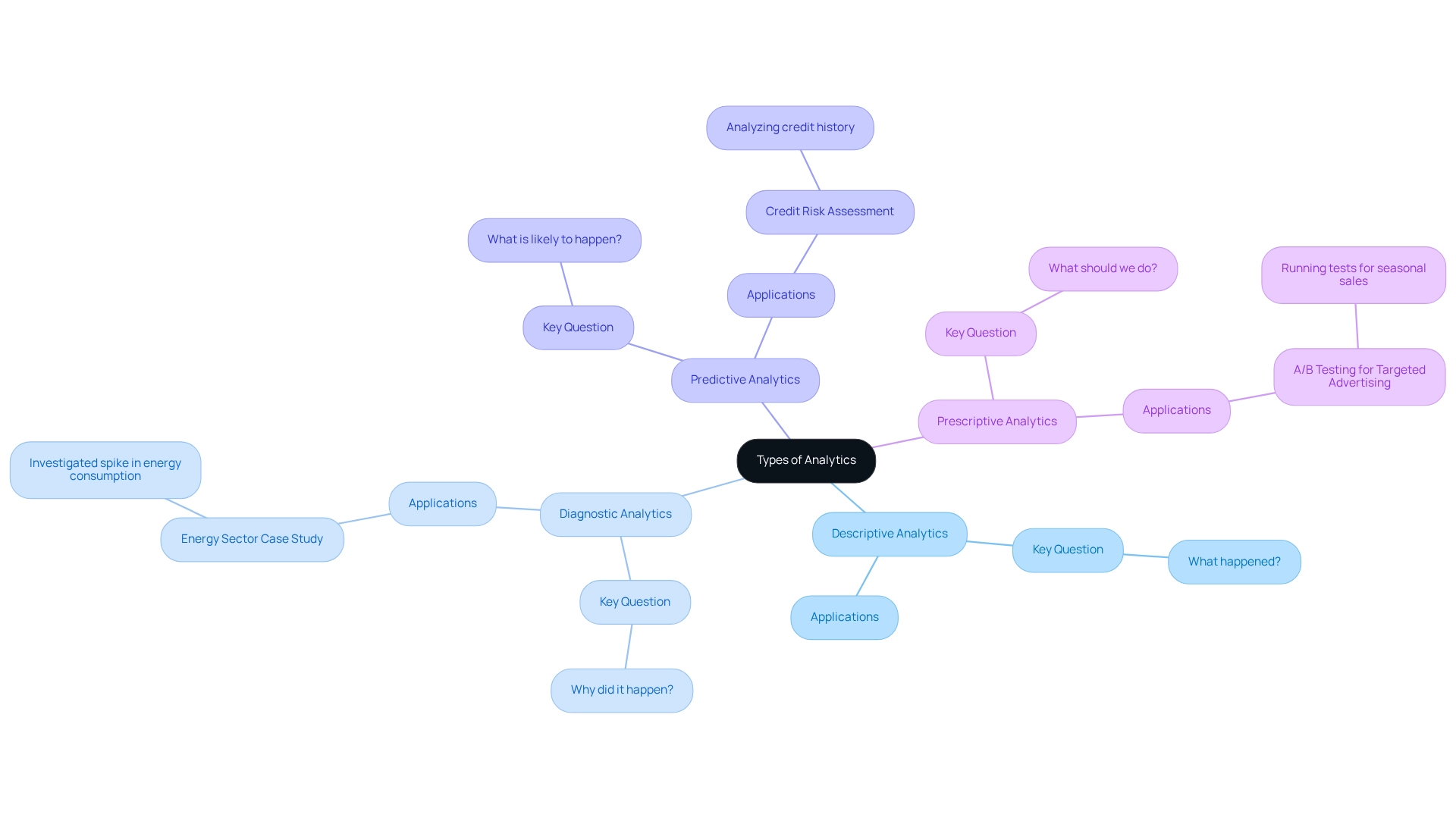
The Future of Diagnostic Analytics: Trends and Innovations
The future of diagnostic assessment is on the brink of significant transformation, driven by advancements in artificial intelligence (AI) and machine learning (ML). These technologies are set to enhance information processing capabilities, resulting in improved accuracy in insights and decision-making. For instance, organizations utilizing accessible large-scale information assessment tools have reported enhanced analysis and decision-making, ultimately improving patient outcomes in healthcare environments.
A study titled ‘Perceived Ease of Use in Big Data Analytics Adoption’ underscores the necessity for intuitive and user-friendly systems. Such tools facilitate superior information analysis and decision-making, thereby enhancing patient outcomes and healthcare delivery.
Moreover, the integration of real-time information analysis is becoming increasingly vital. This capability allows organizations to respond swiftly to emerging trends and issues, thus enhancing operational efficiency. As companies progressively adopt data-driven decision-making, the importance of diagnostic analysis will continue to grow, particularly in addressing the question of what diagnostic analytics can answer, influencing strategic initiatives across various industries.
Additionally, leveraging Robotic Process Automation (RPA) can streamline these processes by automating manual workflows, reducing errors, and enabling teams to focus on strategic tasks that drive growth.
Current trends indicate that the management of electronic health records (EHRs) is significantly enhanced through large-scale information analysis, improving the quality of care. Statistics reveal that big data analytics can optimize EHR management, leading to superior patient care. Looking ahead to 2025, we can anticipate innovations that further simplify assessment processes, making them more intuitive and accessible.
Expert insights suggest that organizations investing in the development of essential capabilities, including RPA and Business Intelligence, are better positioned to leverage these advancements. This results in improved healthcare delivery, enhanced diagnostic accuracy, and personalized treatment strategies. As noted by Alshareef et al., organizations that invest in these capabilities are poised to achieve better patient outcomes.
In summary, the interplay between AI, ML, and real-time data analysis, alongside the strategic implementation of RPA, prompts us to consider what diagnostic analytics can answer. This evolution is set to redefine the landscape of evaluation, making it an essential component of strategic planning and operational success. The demographic profile of the 288 respondents in the Jordanian healthcare sector, showing a balanced gender distribution and diversity in experience, further emphasizes the relevance of these findings in understanding trends in diagnostic analytics.
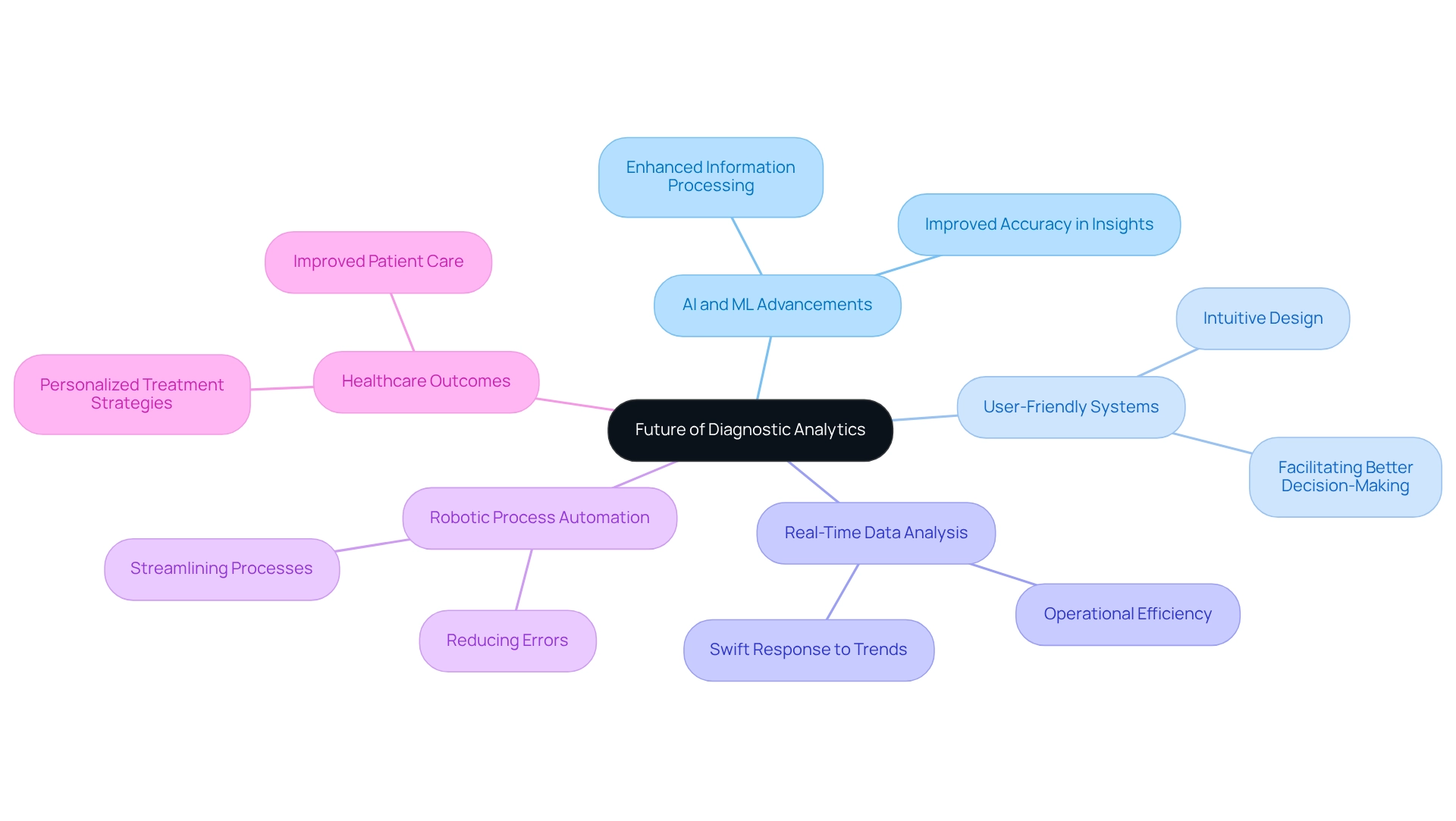
Conclusion
The exploration of diagnostic analytics underscores its vital role in enhancing organizational decision-making and operational efficiency across diverse sectors. By addressing the fundamental question of ‘why,’ diagnostic analytics empowers businesses to uncover the root causes of past events, facilitating informed strategies that drive growth. Methodologies such as regression analysis and root cause analysis illustrate how organizations can transform raw data into actionable insights, ultimately leading to more effective problem-solving and performance improvements.
Real-world applications of diagnostic analytics across industries—from healthcare to retail—demonstrate its versatility and transformative potential. The ability to analyze customer behavior, optimize inventory, and improve patient care not only enhances operational efficiency but also fosters innovation. However, organizations must navigate challenges such as data quality and employee resistance to fully harness these benefits. By adopting advanced analytical techniques and integrating solutions like Robotic Process Automation, businesses can streamline processes and enhance data quality, paving the way for successful implementation.
Looking ahead, the future of diagnostic analytics is poised for significant advancement, driven by artificial intelligence and machine learning, promising to further refine data processing capabilities. As organizations increasingly embrace data-driven decision-making, the importance of diagnostic analytics will continue to escalate. By investing in the right tools and methodologies, businesses can position themselves at the forefront of their industries, leveraging diagnostic analytics as a cornerstone for strategic planning and operational success. In an ever-evolving data landscape, the power of diagnostic analytics emerges as an indispensable asset for driving growth and fostering innovation.
Frequently Asked Questions
What is diagnostic analytics?
Diagnostic analytics is a branch of analytical study that investigates the reasons behind past occurrences or trends by analyzing historical data to reveal root causes of issues, which aids in informed decision-making and improving future outcomes.
What questions does diagnostic analytics answer?
Diagnostic analytics addresses key inquiries such as: 1. Why did sales decline during a specific period? 2. What factors contributed to increased customer churn? 3. Why did a marketing campaign fail to generate expected results?
How does diagnostic analytics improve organizational performance?
By systematically addressing questions about past performance, organizations can uncover underlying issues and develop targeted strategies to prevent recurrence, ultimately enhancing operational efficiency and decision-making processes.
What role does evaluative analysis play in organizations?
Evaluative analysis helps organizations identify inefficiencies and proactively tackle challenges, improving customer retention rates and overall performance through insights derived from historical data.
What tools can enhance diagnostic analytics?
Integrating tailored AI solutions, Business Intelligence tools, and Robotic Process Automation (RPA) solutions can significantly enhance diagnostic analytics by streamlining data gathering and analysis, leading to more effective decision-making.
Can you provide an example of diagnostic analytics in action?
Canadian Tire utilized AI-driven insights to analyze the purchasing behaviors of new pet owners, resulting in a nearly 20% increase in sales by identifying cross-selling opportunities.
What challenges do organizations face when using diagnostic analytics?
Organizations may struggle with differentiating correlation from causation, ensuring data quality, and the demand for advanced analytical skills, which can complicate the effective application of assessment techniques.
Why is understanding past events important in commercial analysis?
Understanding past events is crucial as it helps organizations answer fundamental questions about performance, laying the groundwork for future achievements and innovations.

